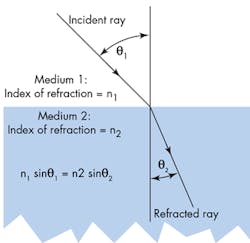This file type includes high resolution graphics and schematics when applicable.
Metamaterials have generated a significant amount of interest over the last 15 years. Due to their unique properties, they offer possibilities in technology that cannot be achieved by natural materials. The field of metamaterials has become a major research topic, as countless research publications have been written on the subject since the year 2000. Metamaterials encompass a variety of disciplines, such as physics, electrical engineering, material science, and optics.
The term “metamaterial” is actually derived from the Greek word “meta,” which means “beyond.” Metamaterials can be defined as artificially engineered materials with properties that are not seen in natural materials. These man-made materials consist of microstructures that are smaller than the wavelength of incident radiation. The metamaterial’s electromagnetic properties are determined by these subwavelength microstructures, resulting in a material with unusual electromagnetic properties. These microstructures can also be known as “metamolecules” or “metaatoms.” Metamaterials can be used to control and manipulate light, sound, and many other physical phenomena.
The electromagnetic properties of a material are defined by two material parameters: electric permittivity (ε) and magnetic permeability (μ). These describe a material’s coupling to the respective electric and magnetic field components of an electromagnetic wave.
The index of refraction is a dimensionless number that explains how electromagnetic radiation propagates through a medium. The index of refraction (n) is mathematically defined as the speed of light in vacuum divided by the speed of light in the medium, as follows:
where
c = velocity of light in a vacuum
vp = velocity of light in the medium
The index of refraction is related to the electric permittivity and magnetic permeability by the Maxwell relation, as follows:
Refraction, simply put, is the bending of a wave as it passes across a boundary separating two media. The amount of bending is described by Snell’s Law (Fig. 1). Snell’s Law is defined by the following equation:
n1sinΘ1 = n2sinΘ2
where
n1 = index of refraction of the incident medium
n2 = index of refraction of the refractive medium
Θ1 = angle of incidence
Θ2 = angle of refraction
Metamaterials can be classified by describing both their electric permittivity and magnetic permeability. They can be grouped into four combinations based on these two parameters:
- ε > 0, μ > 0
- ε > 0, μ < 0
- ε < 0, μ > 0
- ε < 0, μ < 0
Left-handed metamaterials exhibit both negative electric permittivity and magnetic permeability, which results in a negative index of refraction. A negative index of refraction offers great potential because this property is not found in any non-synthetic material. Because of their potential applications, left-handed metamaterials have attracted a great deal of attention from researchers. The term “left-handed” originated because the wave vector is antiparallel to the usual right-handed cross product of the electric and magnetic fields.
Victor Veselago's Concept
Russian physicist Victor Veselago first investigated left-handed metamaterials in the late 1960s. In 1968, Veselago published a paper that theoretically described the electromagnetic properties of a hypothetical material with simultaneously negative values for the electric permittivity and the magnetic permeability. Veselago concluded that a material such as this would have a negative index of refraction.
This conclusion carried enormous implications for almost all electromagnetic phenomena. A negative index of refraction would reverse the Snell effect at the interface between a left-handed material and a normal material. For example, light that enters a left-handed material from a normal material will undergo a refraction that is opposite to what usually occurs.
Modern Breakthroughs
Unfortunately for Veselago, left-handed materials were not known to exist at that time. Thus, his concept remained a mere curiosity for more than 30 years, until the ï¬rst left-handed material was finally conceived and demonstrated experimentally. Sir John Pendry and David R. Smith are regarded as two of the pioneers of metamaterials. In 1999, Pendry and his colleagues proposed a variety of structures they predicted would form metamaterials. They demonstrated that a network of conductor split ring resonators (SRRs) could achieve negative magnetic permeability. This followed the discovery that a three-dimensional network of thin wires could achieve negative electric permittivity.
In 2000, David R. Smith and his colleagues demonstrated the first left-handed metamaterial at microwave frequencies. The following year, Smith and his colleagues continued with a second experiment that confirmed the reversal of Snell's Law, as previously discussed by Veselago. These experiments generated an enormous amount of interest in regards to metamaterials and the possibilities they could offer to extend the properties of conventional materials. Indeed, a tremendous expansion in the field of metamaterials has occurred since the time of these experiments.
This file type includes high resolution graphics and schematics when applicable.
Microwave Components Based on Metamaterials
This file type includes high resolution graphics and schematics when applicable.
The design flexibility offered by metamaterials creates numerous technological possibilities. Metamaterials promise great advancements in the fields of electronics, optics, and more, prompting researchers to propose a wide range of metamaterial-based devices. In the case of RF/microwave components, metamaterial technology can provide significant benefits. Miniaturized, low-noise versions of existing components (such as waveguides, filters, and antennas) can be realized.
Microwave filters can significantly benefit from metamaterial technology, as it has been demonstrated that left-handed metamaterials based on planar transmission lines can be achieved. By using both split ring resonators (SRRs) and complementary split ring resonators (CSSRs), metamaterial filters can be built for use at microwave frequencies. These filters can be fabricated in significantly smaller sizes than conventional planar filters.
As demonstrated by Pendry, the SRR is one of the essential structures of metamaterials. The CSSR, which is a dual counterpart of the SRR, can be energized by an axial electric field rather than a magnetic field. A metamaterial-based bandstop filter can be built by etching an array of CSSRs onto a microstrip line (Fig. 2). This filter can be built in a significantly smaller size than a conventional bandstop filter. A bandstop filter can also be built by etching CSRRs into the ground plane of a printed-circuit board (PCB). These are just two examples of metamaterial-based microwave filters.
Antennas can greatly benefit from metamaterial technology. Small size, low cost, broad bandwidth, and good efficiency are desirable characteristics of an integrated antenna. Because traditional methods of antenna optimization have not had a significant impact, metamaterials have been researched as a means to improve antenna performance.
A great deal of research has occurred to develop small antennas based on metamaterials. These metamaterial-based antennas have been proposed to provide antennas with size miniaturization while maintaining good radiation performance. They also can provide improvements in efficiency-bandwidth. SRRs and other planar structures have been applied in some antenna fabrications to enhance radiation performance and minimize size.
Other designs that have been proposed incorporate artificial magnetic materials with stacks of SRRs under patch antennas. However, achieving wide bandwidth still proves to be a challenge in metamaterial-based antennas. Many approaches have been proposed to increase bandwidth. Research is still ongoing in this area.
One company commercializing metamaterial-based antennas is Kymeta, launched in 2012. The company’s mTenna suite of antennas for satellite communications is built on metamaterial technology (Fig. 3). These extremely thin Ku- and Ka-band antennas use a holographic approach to electronically acquire, steer, and lock a beam to any satellite—without any moving parts.
The mTenna products incorporate tunable elements that are arranged in a precisely calculated pattern. RF energy is scattered when the elements are activated, holographically generating a beam. The direction of the beam is defined by the specific elements that are electronically activated, enabling a design that allows for both continual and instantaneous changes in direction. Earlier this year, Intellian, a provider of stabilized marine satellite antenna systems, announced plans for the next generation Ku-band maritime satellite terminals to integrate mTenna antennas. Kymeta also has plans to release development kits to industry leaders, terminal integrators, and manufacturers.
Another example of a company looking to bring metamaterial-based products to the market is Echodyne. Founded in 2014, the company’s patented metamaterial electronically scanning array (MESA) provides advancements in radar technology. The MESA is thin, light, and relatively inexpensive. Discrete phase shifters embedded in the antenna are used to control the beam direction in traditional electronically scanned phased arrays.
MESA, in contrast, does not require phase shifters at the antenna elements. By eliminating phase shifters, the system’s complexity dramatically reduces, primary sources of power loss are eliminated, and waste-heat dissipation is simplified. MESA supports all radar methodologies and spans the entire radar frequency spectrum from L- to W- band. The company believes MESA has the potential to be used in many applications, including unmanned-aerial-vehicle (UAV), surveillance, aeronautical, and more.
Terahertz Applications
The terahertz (THz) frequency range from 0.1 to 10 THz has been known as the “THz-gap” because technological progress at this frequency range has been slow. The lack of technology capable of producing adequate output power levels in this frequency band has been a major obstacle. As efforts have been made to fill this terahertz gap, metamaterials have attracted interest because of their potential use in terahertz applications. Although efforts are still in the early stages, researchers are working hard to make advancements in this area.
Wireless Power Transfer
Wireless power transfer has been the focus of research efforts in recent years. Several commercial applications have been developed in the last decade, including wireless charging of mobile devices and wireless powering of radio-frequency-identification (RFID) tags. However, these applications are restricted by limitations on the distance, as well as the efficiency of current wireless power transfer technology. By using metamaterials, researchers at Duke University’s Center for Metamaterials and Integrated Plasmonics (CMIP) have discovered a way to wirelessly transmit power over much greater distances.
A method of wirelessly transferring power from a source to a receiver is by means of electromagnetic near-fields. However, the distance between the source and the receiving item must be very small—usually no more than a few feet. Because they can manipulate and focus near-fields, much as a lens can focus or modify visible light, metamaterials have a potentially interesting role to play in wireless power transfer.
Researchers from Duke’s CMIP have demonstrated that the distance between a source and a receiver can be increased with the insertion of a metamaterial near-field lens between them. This technology may lay the foundation for ubiquitous wireless power transferring in the future.
In summary, metamaterials have come a long way in the last 15 years. Researchers today have gained a better understanding of the technology. With companies moving towards production of metamaterial-based devices, metamaterials offer the possibility of being used in a wide range of applications.
Terahertz applications and wireless power transfer are two areas where metamaterials offer the potential to make a significant impact. Microwave components can also benefit greatly, with metamaterials providing improvements in size and efficiency. As efforts are underway to transition metamaterial-based products from the laboratory to the marketplace, we can expect to see more of this technology in the near future.
This file type includes high resolution graphics and schematics when applicable.






